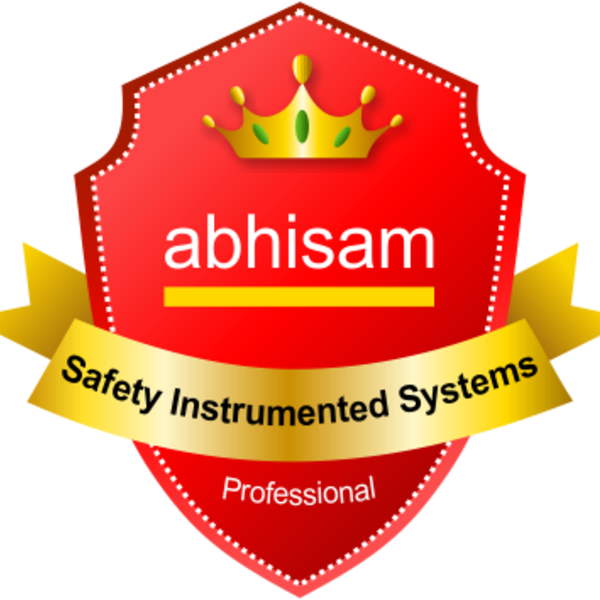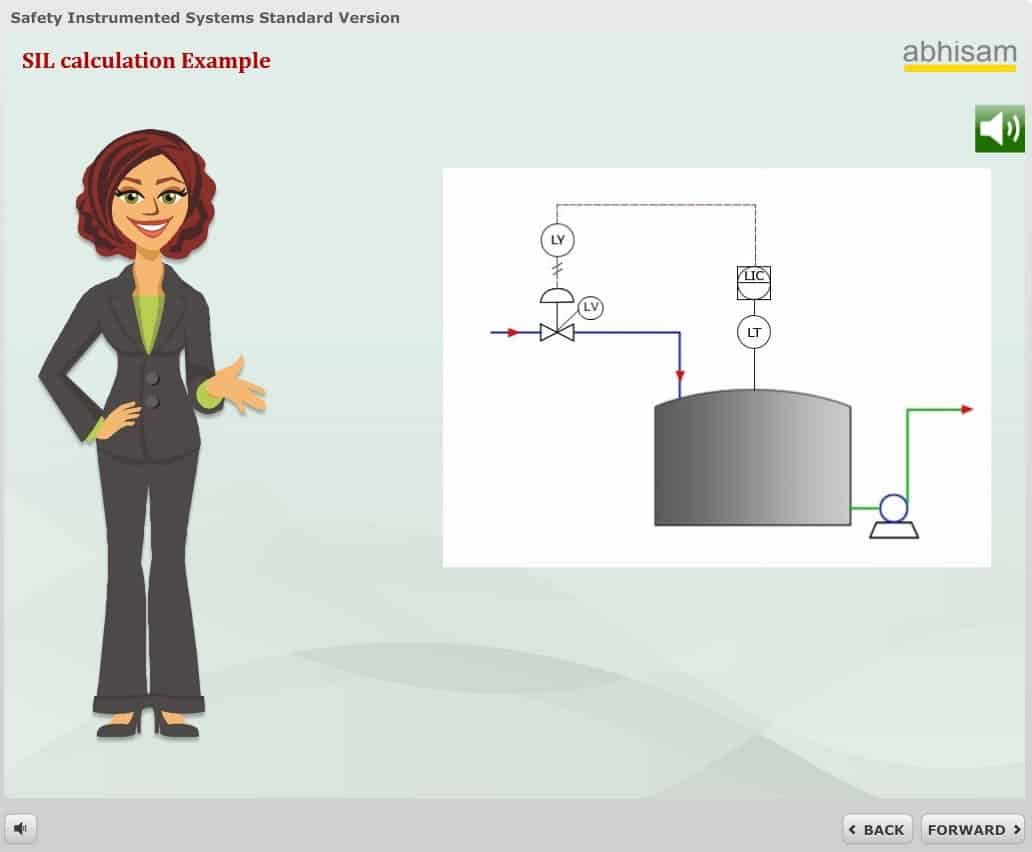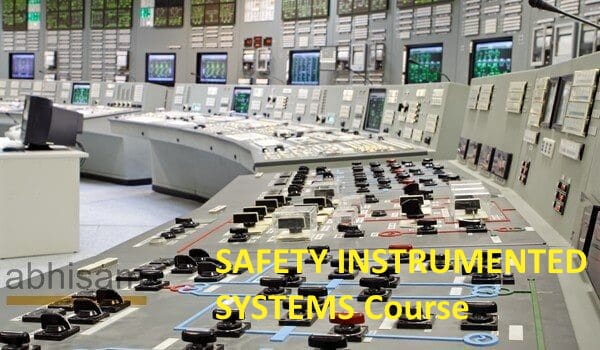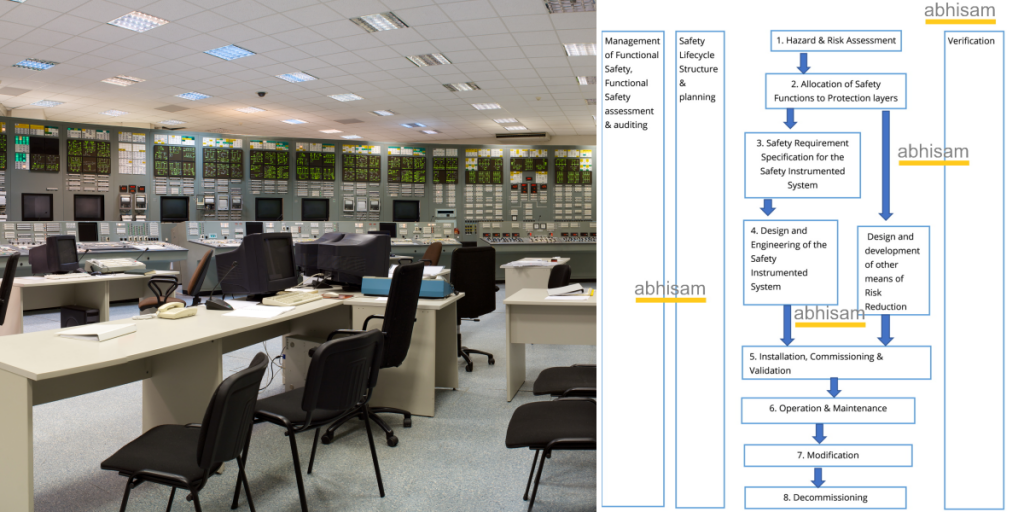Safety Instrumented Systems
What is a Safety Instrumented System?
Safety Instrumented Systems keep plants and equipment safe from unmwanted incidents. If you are an Industrial automation or a Functional Safety professional, it is important for you to know how these systems work and also get yourself certified, as a Safety Instrumented Systems Professional.
What are Safety Instrumented Systems?
Safety Instrumented Systems are a special class of industrial automation systems that are used to implement safety functions to protect assets, people and the environment. In recent years, there have been extensive studies on the best ways of making our process plants safer and the conclusion is, that by just doing one thing right, which is -increasing the reliability of the Safety Critical systems in a manufacturing plant. Taking this Abhisam Safety Instrumented Systems training course is by far the fastest and easiest way of learning about this subject online and getting certified.
Key Benefits of the Course
- Self Paced Course, learn at your own speed, whenever you wish
- Learn from home, office or anywhere else
- Access from any device PC/laptop/Mac/Tablet-no restrictions
- Includes Online Exam and Certification
- Prove your competency by displaying your electronic badge online on social media
- Full fledged e-learning course- Its not a just a Youtube video of a guy speaking, nor a pdf or a PPT, but an interactive course.
- Learn from Real life situations and case studies
Everything that you need to know about Safety Instrumented Systems -in one course!
All the following topics are included. No other course out there covers all of this, at this price! Everything is explained in a very easy to understand manner. Examples from real life situations in manufacturing plants and similar production or storage facilities.
- Introduction & Basic Concepts
- Hazard and Risk Analysis
- Failures & Reliability
- Safety Integrity Level (SIL)
- Safety Instrumented Systems Standards
- How to implement a Safety Instrumented System
- Testing and Maintenance
So what are you waiting for? Get this XPRTU software now, access it online.
Get Certified as a Safety Instrumented Systems Professional! Earn an electronic badge that you can display online


Customer Reviews
“I have worked in the International Oil and Gas Industry as a technical instructor for more than thirty years. I have both used and recommended the products of Abhisam. I recommend them highly to all engineers and technicians in our industry. No praise is too great!!“
John Longden
GCGI LCGI. Senior Trainer
Petroleum Training Institute, UK
I am working in one of the world’s leading EPC companies, engaged in the Oil & Gas industry. I have purchased the Safety Instrumented Systems, Hazardous Area Instrumentation e-learning courses and Hazardous Area Classification. All of them are excellently crafted, the best available online, with excellent support via email.
I appreciate the good work done by Abhisam and hope that they do come out on more such courses.
D. Jha, Engineers India Ltd
New Delhi, India
The course has a large number of easy to understand Animations & Simulations to understand difference between process safety and functional safety. Understand how safety instrumented functions work. A picture is worth a thousand words. An animation is worth a thousand pictures. Concepts get understood easily. Compare this to listening to a boring lecture! Below is a small sample of the numerous animations and simulations that you will learn from.
How can I implement a Safety Instrumented System?
This course has plenty of Safety Instrumented Systems examples. Learn how to do a SIL Determination, Design & Verification from actual real life examples. Everything is explained in a Step by Step method, you can use the same methods in your own plant or project to design your safety instrumented functions!

The course has a Self Assessment Test, that helps you gauge your own understanding of the subject. Get immediate feedback on whether you correctly answered the question or not. This also helps you prepare for the online Certification Exam, that you can take & get a Certificate for free!
Learners from leading companies have taken this course and got certified
The Abhisam Safety Instrumented Systems course has been taken by hundreds of learners from all over the world. They work as engineers, managers, executives, trainers and consultants for leading companies around the world. Here’s a sample of the marquee companies who have used this course to train their learners.
Note: All logos belong to their respective owners.
Choose from any of the versions.
Scroll below to see complete contents.Standard
For one learner-
Course Duration: 40 hours of self paced learning (Earn 40 PDH)
-
Access the course online 24/7 via any device for one year
-
Exam & Certification for one learner
-
Lifelong Valid Certificate
Professional
For one learner-
Everything in Standard plus
-
Access course for 3 years
Get Trial Course Access to all Abhisam courses, including this Safety Instrumented Systems course for $7. You will NOT be billed automatically after trial ends.
Table of Contents
Click the + sign to expand
MODULE 1- Introduction to SIS
What are Safety Instrumented Systems?
Basic Ideas about SIS
Functional Safety
Instrumented Systems & Safety Instrumented Systems-1
BPCS (Basic Process Control System)
Basic Process Control System and Safety Instrumented System
Safety Instrumented Function (SIF)
Emergency Shutdown Systems
Need for a separate Safety Instrumented System
Simulation exercise
Learnings from the exercise
Typical architecture (including sensors logic solver and final control element)
Integrated Basic Process Control System & Safety Instrumented System
Examples
Safety PLCs (Safety Logic Solver) & General Purpose Programmable Logic Controllers
BPCS and SIS
Differences between the Basic Process Control System and the Safety Instrumented System
Q1
Q2
Q3
Q4
MODULE 2 – Hazards, Risks & their analysis
Hazards & Risks
Types of hazards- Fire & Explosions
Types of hazards-Toxic Material
The Safety Lifecycle
Steps in analysis
Preliminary Hazard Analysis
HAZOP
HAZAN
QRA
Consequence Analysis
Risk
Risk Example
Risk Reduction
The ALARP principle
Risk Reduction in process plants
Risk Reduction explained
Risk reduction using a Safety Instrumented Function
Layers of Protection
Layers of Protection in the process industries
Preventive & Mitigative layers
Safety Requirement Specification
SRS Importance
SRS-Minimum Requirements
Q5
Q6
Q7
Q8
MODULE 3 – Failures & Reliability
Failures
Why Study Failures
Types of Failures
Random Failures
Systematic Failures
Random or Systematic
Common Cause Failures
CCF Example
Control of Failures
Avoidance of failures
Diversity
Dangerous & Safe failures
Safety Systems and Subsystems
Safe Failure Fraction
SFF Pie Chart
No Part & No Effect Failures
Easy SFF
SFF calculation example
SFF Manipulation
Proof Test Interval
Diagnostic Coverage
Reliability
Failure Rate
MTTF (Mean Time To Failure)
MTTR (Mean Time to Repair)
MTBF (Mean Time Between Failures)
Failure Data
Software Reliability & Fault injection
Reliability Block Diagrams
Redundancy and Reliability
Fault Tree Analysis
Fault Tree Analysis Example-1
FTA and RBD
Fault Tree Analysis Example-2
Fault Tree Analysis – Probabilities
Event Trees
Event Tree Components
Event Tree Analysis Example
Fail – Safe and Fail Danger modes
Failure Modes Effects and Diagnostic Analysis
FMEDA & Reports
How to use the FMEDA report
Example FMEDA report
Redundancy
Redundancy and Voting
Voting Systems 1oo1
Voting Systems 1oo2
Voting Systems 1oo2D
Voting Systems 2oo2
Voting Systems 2oo3
Spurious Trips
Concept of Demand
Demand in a plant
Low Demand & High Demand
Continuous Demand
PFD
PFDavg
Q9
Q10
Q11
Q12
MODULE 4 – Safety Integrity Level
Introduction to Safety Integrity Levels
What is a Safety Integrity Level (SIL)?
What SIL is not
Safety Integerity Levels -SIL 1 to SIL 4
Is SIL applicable to me?
SIL Study
SIL for Demand Mode
SIL Caveat
Low Demand Mode
Safety Integrity Levels for Continuous / High Demand Mode
- SIL Table for High Demand and Low Demand Modes
The Safety Integrity Level process
Common SIL Questions
Systematic Capability
Concept of Element
Systematic Capability Synthesis
Synthesis of elements
Achieving Systematic Capability
Architectural Constraints
Introduction to Architectural Constraints
Target SIL-Qualitative & Quantitative methods
Risk Reduction Factor
Safety Availability and PFDavg
SIL calculation Example
SIL 4
Consequence Only Method
Hazard Matrix Method
Hazard Matrix Method – Example
Risk Parameter Graph
Calibrated Risk Graph
LOPA
Conducting a LOPA
LOPA Method
More about LOPA
LOPA Example
Target SIL & SIL verification
SIF design process
PFD of a simple loop
SIL verification example – 1
PFDavg-Complex Loops
Markov Modeling
Simplified Equations
Use of Simplified Equations
Architectural Constraints
Hardware Fault Tolerance
Type A subsystems
Type B subsystems
Which Architectural Constraints to follow?
Hardware Fault Tolerance – IEC61508
Architectural Constraints-IEC 61508
Architectural Constraints – Example
Architectural Constraints – IEC61511
Architectural Constraints- IEC 61511 Ed 2
Use IEC 61508 or IEC 61511 Constraints?
Proven in Use
Proven in Use & Prior Use
HFT example
Verification Calculation Procedure
Series and Parallel Architecture
Resolving a Series Parallel Architecture- Example
Verification Calc Example
Conclusion
Q13
Q14
Q15
MODULE 5 – SIS Standards
Introduction to Standards in SIS
AK 1 to AK 8
International Electrotechnical Commission Standards
IEC 61508
IEC 61508:2010
E/E/PE systems
Safety Lifecycle
IEC 61508-Safety Life Cycle
IEC 61511 – Basics
Relationship between IEC 61508 & IEC 61511
Which standard do I follow?
Certified Devices
Revisions-IEC 61508
No Part & No Effect
Architectural Constraints
Security
ISA S84 Background
ISA S84 Differences
IEC 61511
Functional Safety Management
Where to get standards
What standards apply to me?
Conclusion
Q16
Q17
Q18
Module 6-SIS in practice
Components of the Safety Loop
Types of logic Solvers
Hardwired logic solvers – Trip amplifiers
Hardwired logic solvers – Gates
Safety Relays – Electromechanical
Safety Relays – Electronic
Programmable Logic Solvers
Safety PLCs & General Purpose PLCs
Safety PLC Design Techniques
Safety PLCs & General Purpose PLCs
Fault Diagnostics
Safety Logic Solvers-Inputs
Safety Logic Solver-Processors
Safety Logic Solver-Outputs
Safety Logic Solver-Software
Safety Logic Solver-Software-Design
Safety Logic Solver – Voting architecture
Safety Logic Solver – Triple Modular Redundancy(TMR)
Safety Logic Solver – Quad Modular Redundancy(QMR)
Safety Logic Solver Interface to BPCS
Safety Networks
High Integrity Pressure Protection System – HIPPS
Conclusion
Q19
Q20
Q21
MODULE 7 – SIS Testing & Maintenance
Need for testing- Safe State and Unsafe state
Testing – Example
Breakup of failures
Testing the components of a SIS
Testing Sensors & Transmitters
Testing Logic Solvers
Testing valves
Valve Testing – Bypass method
Partial Stroke Testing – 1
Partial Stroke Testing – ISA method
Valve Testing- Mechanical Stoppers
Valve Testing – Smart Positioner method
PST-Advantages & Disadvantages
Testing and PFDavg
Security Assessment
Testing for Stuxnet
Conclusion
Q22
Q23
Q24
Conclusion
A Self assessment Tests is included in the modules.
What are Safety Instrumented and Critical Control Systems? Why are Safety Instrumented Systems important?
These systems help safely shutdown plants in case of emergencies, plant upsets or when the basic industrial automation controls of the plant fail. These systems are the last layer of protection available to a plant, which prevent unwanted incidents.
Companies have realized that negligence (or ignorance), in respect of an instrumented system and especially of a Safety Instrumented System can be really disastrous, literally. Look at just a few recent cases that have been listed below (scroll down to see).
 Incident: Caribbean Petroleum, Puerto Rico, 2009– Accident caused due to non working of the overfill protection instruments (part of the Safety Instrumented System). A massive fire and explosion sent huge flames and smoke plumes into the air at the Caribbean Petroleum Corporation near San Juan, Puerto Rico. The resulting pressure wave damaged surrounding buildings and impacted moving vehicles. The final report into the incident was released by the US Chemical Safety Board and it was non working of the overfill protection system (part of the Safety Instrumented System).
Incident: Caribbean Petroleum, Puerto Rico, 2009– Accident caused due to non working of the overfill protection instruments (part of the Safety Instrumented System). A massive fire and explosion sent huge flames and smoke plumes into the air at the Caribbean Petroleum Corporation near San Juan, Puerto Rico. The resulting pressure wave damaged surrounding buildings and impacted moving vehicles. The final report into the incident was released by the US Chemical Safety Board and it was non working of the overfill protection system (part of the Safety Instrumented System).
Morgantown, North Carolina,USA, 2006
Explosion at a polymer manufacturing plant led to total damage of the facility, with a human fatality and several injuries. Investigations found out that a lack of process safety standards and non implementation of automatic interlock systems (in other words, logic solver of the Safety Instrumented Systems) as the root causes of the disaster.
 Buncefield, UK, 2005- non working of the Overfill prevention system (part of the Safety Instrumented System)
Buncefield, UK, 2005- non working of the Overfill prevention system (part of the Safety Instrumented System)
The Buncefield industrial disaster was one of the biggest disasters to strike the chemical and petrochemical industry in Europe in recent years. The blasts that occurred were so loud, they were heard as far away as France! (Buncefield is in the UK) The root cause was found out not because of the logic solver but due to a bypassed level switch (part of the Safety Instrumented System) on the site.
To make these systems work for you, you need to know them thoroughly ( We mean not from a programming point of view but from a users point of view). You need to get trained in all the concepts and ideas, including applicable codes and standards, ( including international Standards for safety instrumented systems such as IEC 61508:2010 and IEC 61511:2016, ISA S84) plus good engineering practices of these critical Systems. Note that here, when we refer to such systems, we also include Emergency Shutdown Systems (ESD), Safety Shutdown Systems, High Integrity Pressure Protection Systems (HIPPS) and all similar systems that are used to ensure the safe operation of plant and machinery, using highly reliable instruments, controllers, valves and other electrical and pneumatic/hydraulic elements and devices.
A SIS consists of several safety instrumented functions, also known as SIFs that include sensors, logic solvers and final control elements like actuators, control valves and dampers.
Get immediate access to this easy learning program (that we call an XPRTU-since it makes you into an expert).
Learn everything, take an online exam and get your Certificate of Competency, alongwith an electronic badge that you can display online on places like LinkedIn. It is all included in one low price!
You can simply get access to this e-learning course and learn all about these systems, in the comfort of your home or office, in a very easy to understand manner. Simple and easy to learn, with several interactive animations and simulations, this is a great learning experience.
Just get this interactive, self paced training course today and for a fraction of the price that you would otherwise pay for any other course, learn everything that you wanted to know about it (but didn’t know whom to ask). Note that this course is
NOT a Safety Instrumented Systems PPT
NOT an ebook
NOT a video of a guy speaking
It is a comprehensive, software based learning program that combines interactive animations and simulations, real life examples & situations from real plants and facilities, an explanation of all difficult to understand terms in very easy language, a self assessment test and much more. It is a unique learning experience and we daresay that it is the only such program today in the world.
You can get this excellent, self paced, e-learning software based training course from Abhisam and be assured that
a) You will get instant access within minutes when you click the Buy button below and process your payment
b) You will get an easy learning experience due to the extensive graphics, animations, real life examples and situations, calculations, videos, assessments in the course, which has been created by Abhisam, pioneers and global experts in technical e-learning
c) You can get certified as an Abhisam Safety Instrumented Systems professional at no extra charge with a lifelong valid Certificate . Also earn an electronic badge that you can display online on places such as LinkedIn.
d) Earn Professional Development Hours (40) for this course.
Free SIS information and Whitepapers
Contact Us by filling the form below OR call us OR email



